Card rarity is a very important part of Hearthstone. While some might argue that Common through Epic rarity doesn’t really matter and is just a way to introduce artificial scarcity, the final rarity – Legendary – is different. Legendary cards are special in multiple ways. The cards depict unique, “named” characters (or, more recently, items like Legendary weapons), making them stand out flavor-wise. Given their unique, often very powerful capabilities, they’re also limited to one copy per deck (as opposed to two copies of non-Legendary cards). Every expansion had its own set of strongest and coolest Legendaries, and given that we’re already past 4 years since the first adventure went out (Curse of Naxxramas), it might be the right time to showcase some of the best Legendaries that were ever printed.
Since there are so many of those, I’ve decided to split the article into two parts – one talking about Neutral Legendaries, and the other one about Class Legendaries. I’ve decided to stick with Minions – we’ve already ranked the best Quests, Death Knight Heroes or Legendary weapons, not to mention that it’s pretty difficult to draw a comparison between those Legendaries and the minions.
Important – read before proceeding to the list. When creating this list, I looked at the cards’ overall performance against the field during the time they were in Standard. I’m NOT ranking them on how they perform in the Wild format, and when talking about a card that’s still in Standard, I’m taking both the present and the past into account. For the cards that were nerfed, I’m considering their pre-nerf state (as long as they made enough impact to even be on the list) as well as the post-nerf state. The order of cards is alphabetical, it would be night impossible to objectively rank them.
If you’re looking for the list of Best Class Legendaries, check out this article instead!
Honorable Mentions
But first, I’ll start with a bunch of honorable mentions. Those are the Neutral Legendaries that were close to getting on the main list, but didn’t quite get there. Maybe they weren’t impactful enough, maybe they weren’t relevant for a very long period of time, or maybe despite their strength they haven’t left a lasting impression. It doesn’t mean that they’re bad, oh no. They are mentioned for a reason. 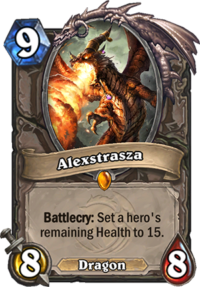
Alexstrasza – She’s been with us throughout the years, but always somewhere in the corner of the meta. Most of the time used as a set up for combos. Even though it stretches the combo over two turns, having your opponent start at 15 makes killing them much easier (unless he has tons of Armor stacked – that’s one thing Alexstrasza doesn’t really help with).
Barnes – Barnes by himself was an okay Legendary, but once people have realized that the can be used with Y'Shaarj, Rage Unbound, players have flipped every time they’ve seen him. While not the most consistent combo, pulling 3/4 + 1/1 + 10/10 on Turn 4 was good enough for Barnes to see play in a bunch of decks, sometimes with Y’Shaarj being the only other minion in the deck to make it consistent (e.g. Spell Hunter).
Bloodmage Thalnos – Thalnos is one of the Classic Legendaries I always recommend crafting. Not because it’s flashy or super powerful, but because it’s been a consistently solid card. Cheap Spell Damage that cycles itself once you don’t need it comes handy at times. However, the thing is, the card is never absolutely necessary to play the decks and you can usually play with some budget replacement instead.
Brann Bronzebeard – Until Brann, most of the Legendaries that you had to answer as quickly as possible came much later than Turn 3. While leaving Brann for a turn rarely lost you a game on the spot, the longer he stayed on the board, the more snowbally it was – doubling Battlecries could carry the entire game. However, the weak 2/4 stats and no immediate impact meant that it was common for the opponents to answer it without you getting any value when played on the curve. It was usually used to combo with some Battlecries immediately – sometimes even as a part of the combos (e.g. 2x C'Thun in Druid). 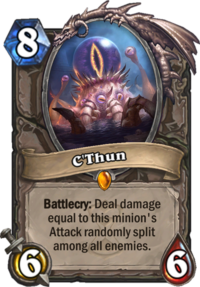
C'Thun – Talking about C’Thun, he was one of the more impactful Legendaries from Whispers of the Old Gods. Despite being the “F2P” Old God (because he was given out for free and decks could be built around him on budget), he used to be the most impactful one for a while. C’Thun Warrior was a very strong deck, especially since you could shuffle two more copies into your deck after the initial one died, giving the deck an incredibly strong win condition. However, his reign in Standard didn’t last very long, as the C’Thun decks were slowly pushed out of the meta.
Genn Greymane – It’s really surprising how much reducing the cost of your Hero Power by 1 can matter. Having a consistent Turn 1 play, easier way to fill the curve and cards that synergy with your Hero Power all make Even decks a thing. For quite a while, Genn used to be stronger than Baku, when Even Paladin was absolutely dominating the meta. Right now, it’s mostly used in Even Warlock and slightly less popular Even Shaman. Since the card is still rather fresh, it will still probably surprise us once or twice.
Justicar Trueheart – She was a way to upgrade your Hero Power when Baku wasn’t a thing. While you obviously didn’t have to restrict your deck building, the fact that you had to draw and play her to get the effect made her not as consistent as you would want for some of the decks. That’s why she ended up being only a Control Warrior staple – the deck took its sweet time anyway, so getting her in the late game was not a problem. However, unlike Baku, she had no place in faster decks.
Medivh, the Guardian – Medivh’s Atiesh felt like a precursor for Legendary weapons. While it came with a rather mediocre stats for its mana cost (8 mana 7/7), you could easily get that tempo back in the upcoming turns. Atiesh summoned a random minion with the same mana cost of the spell you’ve casted, meaning that you could get out three big minions for free. Using that Flamestrike to clear the board and getting a random 7-drop at the same time felt really great. 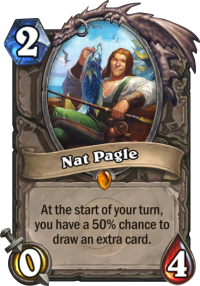
Nat Pagle (Pre-Nerf) – Nat Pagle was THE Legendary to craft back in the day, when his effect used to trigger at the end of your turn instead of the start. It means that you always had a shot at an extra draw, and that he basically drew 0.5 cards more on average. Even the end of turn version would most likely be bad right now, but the meta used to be way, way slower back then.
Sir Finley Mrrgglton – Sir Finley was an amazing 1-drop in aggressive decks that weren’t too happy with their Hero Power. Not only it was a solid 1-drop (I mean, Dire Mole sees common play in Aggro right now), but the fact that you could change your Hero Power as Pirate Warrior (because let’s be honest – 2 Armor per turn is not something you want) pushed it over the edge. However, it had pretty limited use, because you didn’t want to play him in the aggressive decks that already had a good Hero Power (e.g. Face Hunter or Zoo Warlock).
Tinkmaster Overspark (Pre-Nerf) – I’d say that the pre-nerf Tinkmaster used to be one of the strongest Legendaries at the time, but also one of the most frustrating ones. While he was only a 2/2, his effect was targeted. For just 3 mana you could turn the mighty Ragnaros the Firelord into a 1/1 Squirrel and get a 2/2 minion instead. The truth is that even the low-roll of turning him into a 5/5 was good enough, since it decreased the stats AND negated the effect, but the coin flip decided so many games. Even worse if you played it on your 1/1 on the curve to get a 50% chance to turn him into a 5/5. Making him even more random might seem like a bad way to fix the card, but given that it made him nearly unplayable (he has seen some play later as a tech card vs. C’Thun for example), I’m happy that they nerfed it. 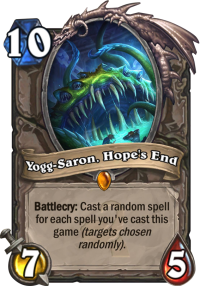
Yogg-Saron, Hope's End (Pre-Nerf) – When Yogg was first revealed, not many have thought that it’s going to be any good. However, it turned out that having a big, red “oh fu..” button in case everything goes badly is always nice. So what that it will fail and kill you or do nothing a lot of time? Even if you could win one out of three of the games that you had no way of winning, that’s still great. The card was absolutely frustrating, because it could turn the entire game around through sheer RNG. Once it got nerfed, it nearly disappeared from the ladder. His effect stopping once he dies was a massive difference, because well, he usually died after just a few spells.
Ysera – Ysera is an interesting card. She was always one of the highest value Legendaries in the game. Between the hard to kill 4/12 body and “infinite” value generation, she has seen play in many metas in the past. However, between her high mana cost and the fact that she’s really slow, she started seeing less and less play once the meta was speeding up (once again, meta back in Classic was absolutely slow compared to most of the future ones). She still sometimes sees play in Dragon decks, but most of the time there are better options.
Zilliax – Zilliax is the new Legendary from Boomsday Project. It’s still too early to put him on the Best list, but he already deserves a honorable mention. After two months, he still sees common play despite Mech decks being nearly non-existent. Most of the decks he’s played in run only 1-2 Mechs (usually Giggling Inventor), or sometimes even zero. He just does so much. Instant removal, healing, small body presence with Taunt – while ideally you want to Magnetize him into something, he proved himself to be good enough even without it.
The Best Neutral Legendaries Ever
Baku the Mooneater
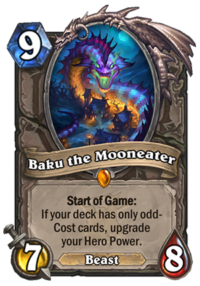
I’ll open the main list with The Witchwood Legendary, one of the pair. Genn Greymane was already in the honorable mentions, but I felt like Baku deserved a spot here. Some of the upgraded Hero Powers are really powerful, especially since they were designed to be played in the late game (Justicar Trueheart). A 2/2 Rogue’s dagger might not be that relevant if you get it in the late game, but if you have it from the beginning? That’s another story. Having either an amazing early game board control or a way to start pushing damage right from the get-go goes a long way. And that’s just a single example.
Right now, we have three popular Odd decks – Paladin, Rogue and Warrior. In each of those cases, having an upgraded Hero Power right from the start is a big advantage. Paladin – flooding the board right from the first turns without using his cards is great, Rogue I’ve already talked about and Warrior… well, +4 Armor per turn is not something you can ignore. Your opponent needs to put 5 Attack on the board in order to even start making a dent in your life total, and his board doesn’t really become scary until he has 7-8 points of Attack in there.
Of course, you need to make some serious sacrifices in order to run him, but Highlander (Reno) decks have already proven that having deck building restrictions is not that big of a deal if you have incentive. However, those specific restriction of Baku & Genn make them significantly weaker or stronger depending on the class. To put it simply, if a class is full of strong Even cards (e.g. Mage), then running Baku is very difficult. It doesn’t stop people from trying, though.
Dr. Boom
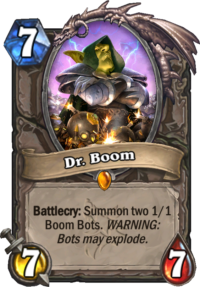
Dr. Boom. Dr. Seven. Dr. OP. Just saying “Doctor” sent shiver down the spines of many Hearthstone players back in the day. Now he is commonly cited as an example of how even pros could easily misjudge the card’s power, but I remember him as the terror of the ladder. The reason why Dr. Boom was so strong was the tempo he provided, back when high cost Legendaries were usually very slow and value-oriented. The 7/7 body for 7 mana wasn’t good enough by itself (War Golem), but two Boombots supplemented it really well.
Their 1/1 bodies didn’t seem scary, but thanks to their effects they always did SOMETHING. They were also one of the best example of unhealthy RNG that didn’t add anything to the game. They could deal anywhere between 4 and 10 damage once you traded both of them, that’s a MASSIVE difference. Let’s say that your opponent had Ragnaros the Firelord on the board. You could run two Boombots into it and kill it, or you could deal 2 damage to it and 2 damage to your opponent’s face. In the first scenario, you usually swung the game back in your favor. In the second – they basically did nothing.
Dr. Boom was a go-to Legendary you put in most of the Midrange and Control decks. You just couldn’t go wrong about it – slam it into your deck and you will increase your win rate. The card was so popular that Big Game Hunter was one of the most common techs (if not THE most common, we don’t really have stats from that period, so it’s hard to tell). It used to cost 3 mana, by the way, so it was also much stronger than it is now.
Dr. Boom is a real success story. From a random Quest target in Netherstorm he became one of the most recognizable cards in Hearthstone, and now he even got his own expansion (Boomsday Project).
Emperor Thaurissan
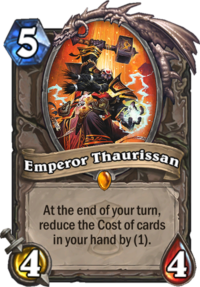
If I had to name my favorite Legendary, it would be Emperor Thaurissan. That’s probably because I loved combo decks built around him, and it’s hard to deny him a spot on this list. Over his time in Standard, he “activated” dozens of Combos. The most powerful combos are usually – for a good reason – too expensive to play in a single turn. They might cost 13 mana, or 15 mana, but the point is that you shouldn’t be able to play all those cards together. Emperor Thaurissan begged to differ. Thanks to the BRM Legendary, players came up with all kinds of crazy and sometimes even broken combos.
The most basic example is probably the Warlock’s Leeroy combo. Leeroy Jenkins + Power Overwhelming + Faceless Manipulator used to be one of the most common finishers in slow Warlock decks (like Reno Warlock), but you couldn’t drop them all in a single turn without a Coin (not very consistent) or a mana discount. He was also a way to activate most of the Malygos combos. For example, Rogue. Normally, with 9 mana Malygos you can only afford to play a 1 mana Sinister Strike and that’s it. With Thaurissan? You could drop Maly, 2x Eviscerate and 2x Sinister Strike on the same turn for 34 damage in total. But probably most infamously, he was used in Patron Warrior to activate the massive Warsong Commander + Grim Patron or Frothing Berserker combos.
Outside of the combos, Emperor was also useful in decks that simply had many cards in their hand at a time. For example, in any kind of slow Warlock, even those without Leeroy combo. I mean, playing a 6 mana 5/5 that gives you a total of let’s say 8 mana discount for your hand was well worth it (at the time, Lord Jaraxxus was also pretty common sight, and reducing his cost to 8 was a huge deal, since you could Hero Power right away).
Mana discounts are incredibly powerful in this game, and Emperor will most likely see play for as long as Hearthstone exists (or until it gets nerfed).
Leeroy Jenkins
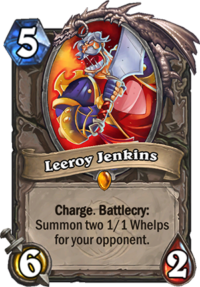
Leeroy Jenkins is one of the few Classic Legendaries that have seen play in basically every meta, and it’s easily the most powerful one. As it turns out, if you play an Aggro deck, you want to have a way to burn your opponent down, and dealing 6 damage for 5 mana is generally a good way to do so. Of course, as a Mage you can just play a Fireball for one mana cheaper, but not every class has this sort of luxury. While it doesn’t come up often, Leeroy also leaves a body behind, so if you deal with the 1/1’s he summons (or at least one of them), there’s a chance that he survives for another attack.
The fact that he’s a minion means that he can also be buffed right away. In Rogue, Leeroy + Cold Blood for 10 burst damage is a quite common play. Back in the day, Leeroy used to be commonly combo’d with Shadowstep too to get even more burst. Another common use was in combo decks – he’s basically the highest Attack Charge minion in the game available for every class (technically Charged Devilsaur has 1 more Attack, but you know, it can’t hit face unless you summon him instead of playing from your hand, making things slightly more difficult). Right now, he sees play in most of the Aggro decks that need some sort of burst finisher.
What’s scary is that Leeroy used to cost 4 mana, just imagine that. Rogue could get 18 burst damage with just three cards and 8 mana – Leeroy and 2x Shadowstep. Which used to be the main win condition of Miracle Rogue (you also slammed a Cold Blood or Eviscerate on top of that if needed, of course).
Loatheb
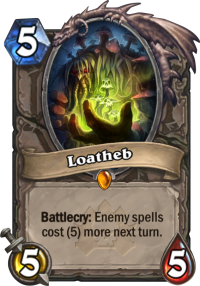
Curse of Naxxramas was a heavily imbalanced set, mostly because it was Team 5’s first attempt at adding extra cards to the game. It gave us a bunch of overpowered cards, and to be perfectly honest, Loatheb was one of the scariest ones. He was a common sight in many decks right until he rotated out, and I’m quite certain that he would see even more play right now if he was in Standard. The card was just so powerful, if you’ve played a Midrange deck there was basically no reason to NOT run him.
5 mana for a 5/5 body isn’t that exciting, but his effect was easily enough to make up for it. Increasing the mana cost of opponent’s spells by (5) for the next turn basically handicapped any Control or Combo deck you’ve played against for a turn. Even if they COULD play their AoE (which usually wasn’t the case), they had to pay premium for it. Even single target removals costed a lot – Warrior having to spend 6 mana to Shield Slam your Loatheb was sweet. The best part is that you’ve usually dropped him when you were already ahead on the board, giving you basically a turn of free punching most of the time.
He was also useful to stop those pesky combo decks for a turn. You knew that Freeze Mage was preparing to kill you? You could at least stall for an extra turn. Druid had Force of Nature + Savage Roar combo prepared? (for those who haven’t played back then, FoN Treants used to have Charge, but died at the end of the turn) Nope, you had one more turn to heal, put a Taunt up or even just kill them.
Yes, sometimes his effect was useless, since your opponent didn’t want to play the spell anyway. But even then at least you’ve got a 5/5 body, which was a solid consolidation prize.
Malygos
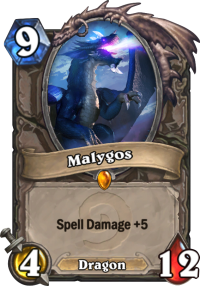
Malygos is to spell-based combos what Leeroy is to attack-based combos. Massive +5 Spell Damage turns even the least scary burn cards into serious bombs. The perfect example is turning a Moonfire into 0 mana Fireball. However, what is easy with Moonfire is much harder with other spells. Malygos’ 9 mana cost means that you can’t combo it with anything that costs more than 1 mana… at least if you don’t cheat your way around it.
And that’s what combo decks have been doing for years already. Of course, they could just drop Malygos one turn and play damage spells on the second (and it sometimes happens, it’s usually a sort of desperate play), but if your opponent kills or silences it, it won’t work. And so, Druids were comboing it with Innervate, Rogues with Coins and Preparation, Shamans with Ancestor's Call and so on and so on. Once Emperor Thaurissan got released, everything became much easier. More recently, Druid is the king of Malygos. Thanks to the cards like Twig of the World Tree, Dreampetal Florist and Flobbidinous Floop, Druids have multiple ways of getting a cheaper Malygos for their combos. Notably, Priest can also utilize it quite well – once it dies once, assuming it didn’t get transformed, Anduin can revive it with Eternal Servitude or Lesser Diamond Spellstone (and then burst the opponent with Holy Smites and Mind Blasts, especially when combined Prophet Velen)
As long as Malygos is in Standard, players will build decks around it. Depending on the other support cards, they might be off-meta, or actually a solid, high tier choices. The latter was true a few times in the past, it is now, and even if Malygos goes out of meta for a while, I’m quite sure that it will eventually come back.
N’Zoth, the Corruptor

If I had to pick the strongest of the Old Gods, that would definitely be N’Zoth. If you played any dedicated Deathrattle effect, then he was obviously the right card to play in there. But dedicated Deathrattle decks were never THAT popular. But once people have realized that you don’t need much to play him, he was commonly seen in most of the slower decks.
I mean, yes, the card costs 10 mana, but already comes with a body worth roughly 5. Revive a big Deathrattle card or two mid-sized ones and it’s already worth it. When Sludge Belcher and Sylvanas Windrunner were still in Standard, those two were enough to make N’Zoth work. For 10 mana, you’ve got a 5/7 + Sludge Belcher + Sylvanas, a great board with just one card.
More recently, just before it rotated out, it was also played in Cube Warlock. Reviving your Voidlords, as well as Carnivorous Cube, Possessed Lackey and even Mistress of Mixtures was a really nice swing in your favor. Over two years the card was in Standard, it has seen play in dozens of different decks
Patches the Pirate (Pre-Nerf)
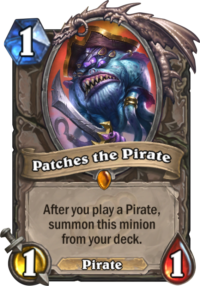
First of all, why am I taking the pre-nerf version into account instead of the nerfed one? It’s quite simple, actually. For the most part of Patches’ reign in Standard, he was in his unnerfed state. His nerf came roughly 2 months before it was going to rotate out anyway, way too late if you ask me.
I don’t think I have to explain why Patches was so common – having a free 1/1 with Charge jumping straight out of your deck is something every deck would want. Of course, it was an auto-include into Pirate decks – why wouldn’t you want it if a big part of your deck triggered it? However, the card was so insane that players were taking extreme measures to include him. Rogues, for example, despite not playing Pirate decks, always had 2x Swashburglar and usually 2x Southsea Deckhand to activate the Patches. Other decks that had NOTHING to do with Pirates, like Aggro Druid or Zoo Warlock, were playing small Pirates just so they could run Patches too. Bloodsail Corsair and Southsea Captain were the two most common choices. The first one was 1 mana 1/2 + 1/1 with Charge, the second one was 3 mana 3/3 + 2/2 Charge, both insane.
Of course, the problem with Patches was always drawing it. If you got him before you’ve played a Pirate, he was basically a Stonetusk Boar with Pirate tag, and that’s not something you would want to put into your deck. To be honest, it created even more unnecessary draw RNG, because the difference between drawing him and pulling him out for free was massive.
The card was nerfed by removing the Charge. It might not seem like a big deal, after all, losing that 1 damage on the first turn is not that relevant. But in reality, that 1 damage is what made it so good. Not 1 face damage, but the fact that you could use it as a ping. Your opponent played a 1 health minion on Turn 1? You could kill it right away. You needed to finish some 1 health minion later? Patches. It was also a 2/2 if you’ve played Southsea Captain, which means that you could trade it into a 2/2 or a 3/2 minion for a really nice tempo swing. Without Charge, the Captain would probably die to a removal or weapon, and then Patches would die to the 2 health minion he would normally kill. To be honest, that’s what he should be from the beginning – he’s still okay in dedicated Pirate decks, in which the chances of drawing him are relatively slim (since you’re playing a Pirate during your first turns in every single game) and I think that he was never meant to be played outside of them.
Prince Keleseth
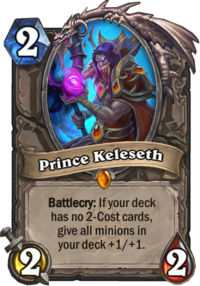
Keleseth is another card that changed the way of how Aggro decks are built. Before Keleseth, it was normal for Aggro decks to run lots of 2-drops – some even considered 2-drops to be the most important part of the deck. Having a strong early game curve was your way to win the games. Once Keleseth came, however, lots and lots of Aggro decks have shifted towards Kelesth + more focus on 1-drops & 3-drops instead, especially 1-drops.
Of course, in a perfect world, if you get Keleseth on Turn 2, having no 2-drops doesn’t really hurt you. You still have a T2 play, and now the rest of your deck is much more powerful. Those games are the reason why you play Keleseth, having him on the curve can increase your win rate by as much as 20-30%. Having +1/+1 on every single minion in your deck is obviously incredibly powerful. They punch harder, they’re harder to kill and some of them even synergize with it – like Saronite Chain Gang, which doubles the buff, since it comes with two bodies.
Of course, it doesn’t mean that you can’t win games without him. Your deck is slightly weaker without 2-drops, but that’s why you either play it in a class which can use their Hero Power on T2 without losing too much tempo (Rogue) or you run a lot and I mean A LOT of 1-drops, so there’s a high chance that you will drop 2x 1 mana minion instead of 1x 2 mana minion on curve.
Alternatively, you run him in decks that just don’t have good 2 mana options. If you were struggling to add any meaningful 2 mana cards to your deck, then it might be time to throw in Keleseth instead. Not only you can put better cards in other mana slots now, but you have a chance to increase you win rate significantly if you get him early.
To be honest, I’m actually looking forward to Keleseth rotating out, because we have basically no regular Aggro decks anymore. It’s either Keleseth or Baku the Mooneater, you basically have to run one or the other (depending on the class) to have a successful, fast deck. And again, it creates a lot of unnecessary draw RNG. If the difference between having and not having him on T2 can cost you 20-30% win rate, I feel like the swing is just too big. But it’s hard to deny that the card is incredibly powerful. It started seeing common play after the KFT nerf patch and he’s staying as one of the most common Legendaries ever since.
Ragnaros the Firelord
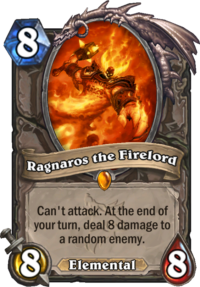
Ragnaros was the first, go-to high cost Legendary you wanted to put in slower decks, even before Dr. Boom was a thing. That’s because it was one of the only high cost Legendaries with some sort of immediate impact. Dealing 8 damage was usually enough to kill any random target. And if you’ve dropped him on the empty board, it was as if it had charge, dealing 8 damage to your opponent right away. That said, unlike Charge minions, if it killed a minion, it didn’t take damage himself. If an 8/8 Charge minion would run into another 8/8, it would die. Ragnaros didn’t – he was as healthy as it was at the beginning.
However, as good as it was, Ragnaros was frustrating to play against, and even play with A LOT of the time. The simplest scenario – your opponent had a big minion on the board. You dropped Ragnaros. Now, it was basically a coin flip. A lot of the time clearing the minion meant that you won the game (because even if your opponent killed Ragnaros next turn, you’ve got both value AND tempo from it) and hitting face meant that you lost it (because it ended up being 8 damage burn for 8 mana and nothing else). But the fact that he was one of the best big minion choices didn’t stop people from running it, running it A LOT.
That was basically the reason why the card got eventually rotated out to Hall of Fame. People got bored of it, and were frustrated about it, but still played it, because it was so good. Rotating it has opened a lot of deck building potential – players were forced to switch to other options. But those who have played back in the day still remember Ragnaros RNG clips in basically every single highlight reel.
Reno Jackson
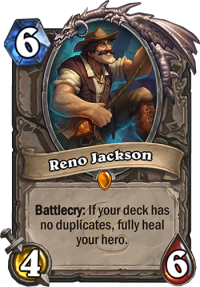
The third Legendary on this list coming with deck building restrictions, Reno Jackson might have been the most powerful out of the three. In a world where a 5 mana 3/3 healing you for 8 was played as a counter-measure to, well, dying to Aggro decks constantly punching you with small minions or combo decks burning you down, a 6 mana 4/6 that healed you to full no matter how low you were was obviously incredibly strong. But it was also the first card that came with a serious handicap – you couldn’t put more than a single copy of each card. It wasn’t a problem for Legendaries, but having to remove one copy of each staple you’ve played was a big deal. Each deck plays 2 copies of many cards simply because they’re the best choices in your deck – one copies is usually reserved for tech cards and such. Forcing that restriction on every card made the deck weaker, but also more diverse / interesting. You had to pick cards you normally wouldn’t play to replace the ones you did want. However, you could play Reno Jackson for your trouble.
Dropping the card vs Aggro usually meant that you won the game, unless they had a massive board lead. Healing up to full and forcing them to work through your life total again when you’re approaching late game already was too much to ask for most of the time. While Highlander decks are associated with 3 classes (Mage, Priest, Warlock) because of the Gadgetzan, initially Reno was played in many different decks. We had Reno Warriors, Reno Paladins, Reno Rogues and even Reno Hunters (although they were more of a meme deck). I think that pro players have attempted a Reno anything when the card was first released. It clearly had a massive impact on the meta. While the interest for it has died out a little with Whispers of the Old Gods and Karazhan, it was reignited again. In Mean Streets of Gadgetzan, more singleton-related cards were added – Kazakus being the one available to all three Kabal classes. Kazakus was also undeniably strong, but Reno Jackson was still the main reason to play those decks.
Sylvanas Windrunner
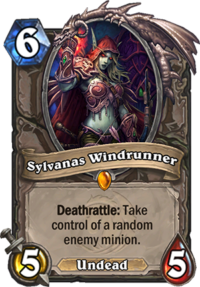
Another Classic Legendary, Sylvanas’ story was very similar to the one of Ragnaros. They were a pair of most common Classic Legendaries that found their way into many, MANY decks – Midrange and Control alike. Unlike Ragnaros, though, Sylvanas wasn’t valued for her initial board impact. On the contrary, you had a 6 mana 5/5 (initially she costed 5 mana, but that mistake was quickly fixed) with no immediate effect. However, her Deathrattle has made them one of the best cards in the entire game at the time. There were times at which your opponent couldn’t do anything but to let you steal one of his minions. He could try to minimize the damage by playing a bunch of small minions and such, but in the end, unless he could Silence her, it usually made his turn really awkward.
The random part of the card lead to some RNG scenarios, like “if I get X I win, if I get Y I lose”, but to be honest, most of the time she was played at times when most of the outcomes were good. Similarly, she was also commonly dropped against a single big minion and killed right away. For example, it was a common play back when C'Thun Warrior was common. Since their strategy was to let the Old God die and then shuffle him back twice, stealing him with Sylvanas ruined the entire plan to the point in which against the decks running Sylvanas, Warrior tried to kill his own C’Thun right away with e.g. Shield Slam.
Notably, she also had an amazing combo with Shadowflame. It was great against boards with multiple small-medium sized minions and one bigger minion (e.g. flood deck which just dropped a Sea Giant) – not only you cleared the board, but have also stolen their biggest minion. Warlocks could also use her as a random Mind Control thanks to Power Overwhelming.
Overall, Sylvanas was one of the most notorious Legendaries in the history of Hearthstone. Some have loved her, others have hated her, but in the end she decided millions of Hearthstone matches.
The Lich King
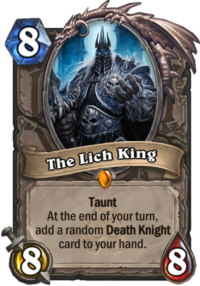
And last, but not list, we’ve got The Lich King himself. He was one of the most anticipated cards (or Heroes, because some players still believed that we’ll get a Death Knight class and Arthas will be a Hero) and players knew what will happen as soon as Knights of the Frozen Throne were announced. At first, he seemed to be… not very exciting. Just an Ironbark Protector mixed with Ysera. And that’s true – by himself, he’s not that interesting. However, Death Knight cards are the main reason why he sees so much play right now. Those are really powerful. 2 mana for 5 damage to any opposing target or 5 healing to any friendly target? 3 mana for 3 AoE? A freakin’ Frostmourne, which summons back any minions you kill with it once it’s destroyed?
The Lich King is all that Ysera wanted to be. Most importantly, it’s not useless vs Aggro because of the Taunt. 8/8 Taunt is often hard to deal with, and I’d say that overall Death Knight cards are also better vs Aggro than Dream cards (although that’s debatable, it depends on the exact deck you face). All in all, The Lich King is a bit like a cheaper Ysera with Taunt.
During KFT, he was by far the most popular Legendary and one of the most popular cards in general. Ever since, it’s nearly always in top 5. If you’re building a slow deck, The Lich King is probably the first high cost card you want to put in there. It’s a bit of what Ragnaros was back when he was still in Standard – a well-rounded, high cost Legendary with a sort of immediate impact (it had Taunt vs Aggro, and even if it died right away vs Control, you still got a card out of it), so his popularity is not a huge surprise and he definitely deserved a spot on this list.
Closing
Oof, it’s been longer than I’ve initially thought it will be. But there are so many great Legendaries, and so much to talk about. Some of the “best” choices were really difficult, and the line between some of the honorable mentions and actual list is thin.
What do you think about the list? Do you agree with it? What are, in your opinion, the best Legendary minions in Hearthstone? Neutrals, that is, because I’ll have a separate list for Class Cards too!
Anyway, thank you all for reading it. Good luck on the ladder and until next time!

I might add Zola to this list…
Ms. Stinky Cheese is key to so many combo decks, Shudderwock, Quest Rogue (or any rogue going infinite with the DK), OTK Paladin, etc. One of the few neutral legendary cards to be in several of my Rank 5-Legend decks across a range of at least 3 classes at the same time.
Could you always include what the cards were pre-nerf?
I can’t always remember pre-nerf stats from 4 years ago. Newer players would have no way of knowing.
Since the pre-nerf was the basis of your selection, it’s essential to know what those stats/effects were.
But I did talk about what the cards looked like before they were nerfed, in their description. Maybe not directly, but it should be very easy to understand what they did after reading. E.g. Yogg:
“His effect stopping once he dies was a massive difference, because well, he usually died after just a few spells.”
Or Nat Pagle:
“Nat Pagle was THE Legendary to craft back in the day, when his effect used to trigger at the end of your turn instead of the start.”
He did say all of them
No mention of either Elise Starseeker? I remember the original Elise was included in many control decks, especially Control Warrior, to win the control vs control match ups. The new Elise from Un’Goro had a similar role. Any reason those weren’t mentioned?
The original Elise wasn’t played all that much. She was only relevant in Control Warrior and for a short period of time. E.g. Justicar Trueheart was way more important in Control Warrior for a longer period of time and she barely got a honorable mention.
I have considered the new Elise, because she had more impact overall (in Control Priest before, for example, and in Odd Warrior now), but I didn’t feel like that was enough when compared to other cards on the list. I had to make A LOT of cuts, because the list would just get too long. Brann or Justicar Trueheart were the “bottom” of honorable mentions and I believe that they’re more important than Elise Trailblazer. I could consider cutting Zilliax, but that was a hard choice, since it’s a new card. I feel like so far Zilliax made a bigger impact than lots of other Legends (including Elises) have made at their peak of popularity, so that’s why it landed in honorable mentions despite being less than 2.5 months old.
You’re free to disagree with the list, though! There’s no objective metric for rating the Legendaries, especially comparing cards that were never in Standard at the same time.
So very factual and levelel headed. Ever thought about being a judge stone? ?